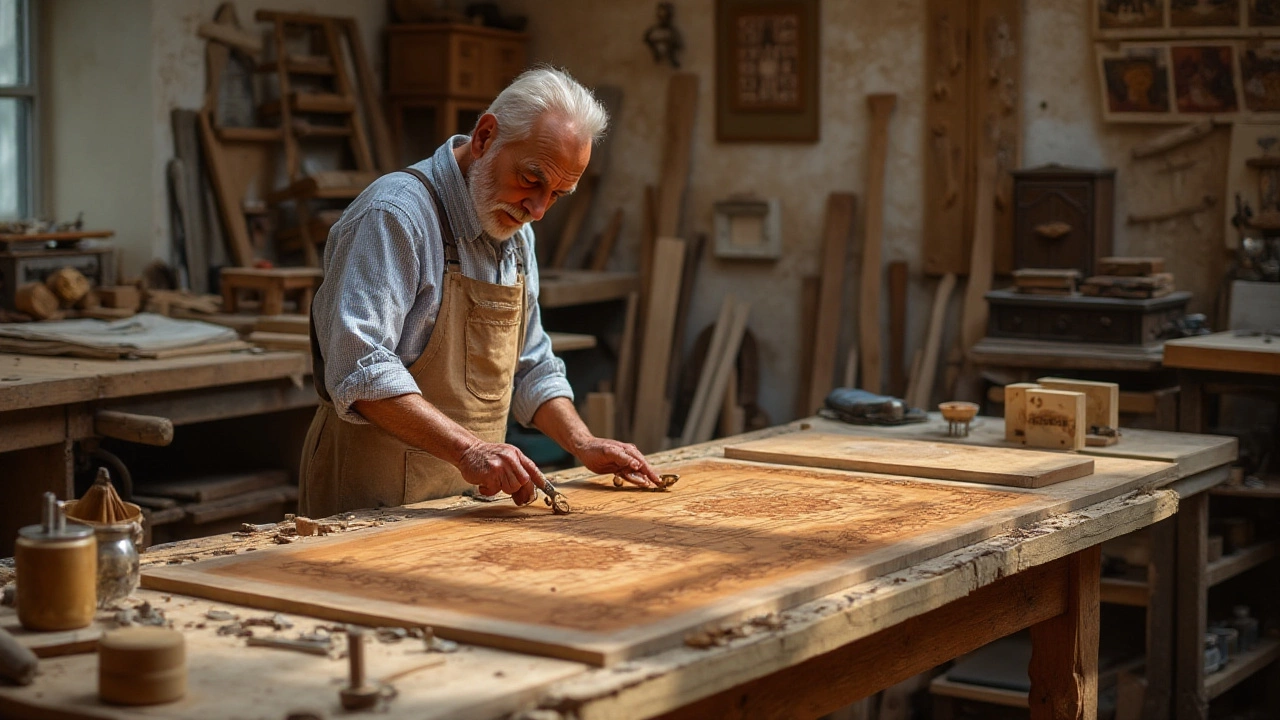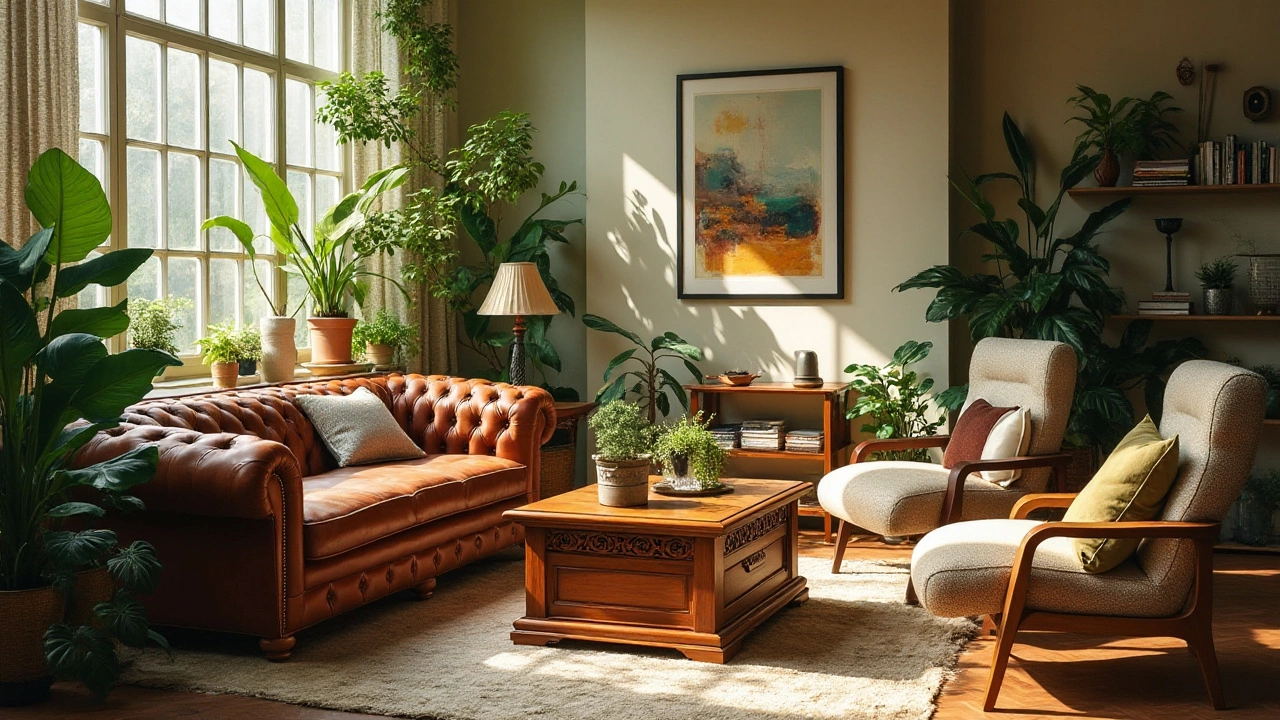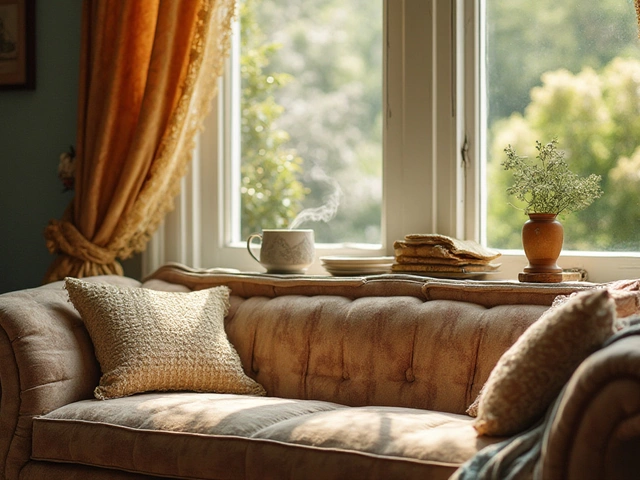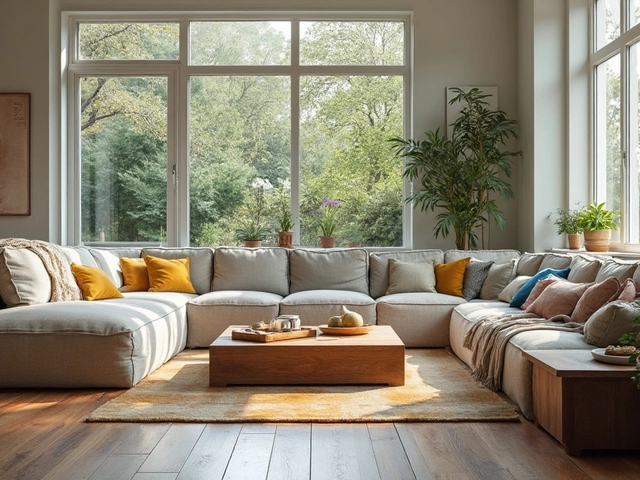When it comes to crafting furniture that not only serves a function but also stands as a piece of art, the world offers incredible diversity in styles and traditions. The quest for the best can often be subjective, influenced by personal taste, cultural heritage, and specific needs of your home or office space.
From the rolling hills of Tuscany with their hidden workshops creating classical pieces to the quiet, snow-draped towns of Scandinavia where minimalism speaks louder than words, the story of furniture making is rich and diverse. Each corner of the globe contributes with its own unique flair and history, turning a simple wooden chair into a masterpiece.
As we explore these renowned regions, we'll uncover what makes each one special, offering guidance and insights into selecting pieces that can truly transform your living space into something extraordinary.
- Unraveling Italian Furniture Mastery
- Scandinavian Design: Minimalism at its Best
- American Craftsmanship: A Blend of Tradition and Innovation
- French Elegance: Where Art Meets Function
- Japanese Simplicity with a Touch of Spirituality
- Choosing the Right Furniture for Your Home
Unraveling Italian Furniture Mastery
When one thinks of Italian artistry, it's impossible to ignore the profound impact this culture has made on the world of furniture. From the opulent designs of the Renaissance era to the sleek, modern pieces that hold prominence today, Italian furniture makers have consistently set trends that others follow. Italian manufacturers have coupled an unwavering dedication to quality with an eye for aesthetics, creating items that are not just functional but truly pieces of art. In regions like Tuscany and Lombardy, the landscape is dotted with workshops brimming with skilled artisans who carry centuries-old techniques passed through generations. These are not merely furniture producers; they are custodians of a rich heritage that marries tradition with contemporary styles.
Italy's furniture industry thrives on diversity, offering everything from the robust, warm woods used in rustic Tuscan tables to the sleek lacquered finishes seen in Milanese contemporary designs. The secret, many say, lies in the fusion of cutting-edge technology with an appreciation for traditional craftsmanship. Brands like Poltrona Frau and Cassina have their roots in this duality, offering products that satisfy an international clientele while staying true to Italian roots. It's about creating a distinct identity where form meets function, and the personality of the piece shines through. The success of these brands underscores Italy's role as a leader in the world of home decor and design innovation.
The Essence of Material and Design
The materials used in Italian furniture are as crucial as the design itself. Italian artisans are known for sourcing only the finest woods, fabrics, and metals. Walnut, beech, and cherry are favorites, each chosen for its durability and beauty. Leather is another staple, its soft touch and natural hues a testament to Italy's renowned leather-working traditions. The combination of these high-quality materials with meticulous attention to detail ensures that each piece is both a luxurious statement and a lasting investment. This philosophy that 'quality never goes out of style' is what keeps Italian furniture at the forefront of global markets.
"In Italy, having genius but not following tradition is like expecting a tree to grow without roots." – Giorgio Armani
Attention to detail is paramount; even the smallest element can significantly impact the final piece. Experienced artisans, often working with their families, infuse their creations with a sense of soul and history. Visitors to a workshop may observe generations working side-by-side, exchanging knowledge and techniques, ensuring that the essence of Italian craftsmanship is never diluted. This dedication to craft and quality transcends the boundaries of mere furniture making; it is a way of life.
Italian furniture also capitalizes on innovation without forsaking tradition. Whether it’s integrating new technology into design or exploring sustainable production methods, Italian brands lead by example. Their ability to adapt and evolve while remaining anchored in their rich history highlights a dynamic resilience. Not only does this approach cater to a sophisticated clientele seeking elegance and functionality, but it also places Italia as a beacon of inspiration for budding designers and established names alike in the furniture industry.
Scandinavian Design: Minimalism at its Best
Scandinavian design is more than a style; it's a philosophy rooted deeply in the landscapes and lifestyle of the Northern European nations. Emerging in the 1950s, this design movement captivated the world by offering simplicity and functionality in an era where ornate and cluttered styles were the norm. It prioritizes a minimalist approach but not at the expense of comfort or warmth. In fact, warmth is a key element, contrasting the cold climate that has shaped such practical yet aesthetically pleasing designs. Natural materials like wood, cotton, and wool often take center stage, employed in ways that highlight their beauty while ensuring durability.
One cannot discuss Scandinavian design without acknowledging the profound influence of designers like Arne Jacobsen, who brought to life the iconic Egg Chair in 1958. This chair, with its fluid lines and organic shape, perfectly illustrates how Scandinavian designers balance form and function. The quintessence of this design ethic is found in clean shapes, muted colors, and subtle elegance. A living room adorned with a sleek Nordic sofa, light wooden coffee table, and strategically placed lamps might seem understated on the surface, yet it quietly transforms the space into a serene refuge.
The aesthetics of Scandinavian design also extend into sustainable practices. Emphasizing the use of local materials and craftsmanship, this style promotes environmental consciousness. According to the Nordic Council of Ministers, the resilience of regional forests has reflected significantly in their strong wood consumption culture that doesn't compromise sustainability. One might come across pieces that are both intricate and robust, embodying sustainability not as a trend but a way of life.
"In designing sustainable products, Scandinavians forewent trends, focusing instead on timeless beauty," notes design expert Sophie Bélanger.
Scandinavian furniture often doubles as multi-functional pieces, an homage to practicality. A bed might feature cleverly concealed storage, a table that extends or contracts to accommodate different spaces, or shelves that pivot or fold against the wall. Size and scale are tailored to real homes, breaking from the tradition of opulence in favor of user-friendly design that complements rather than dominates a room. This capacity for adaptability highlights the core belief in making life uncomplicated, efficient, and enjoyable.
Moreover, the appeal of Scandinavian furniture transcends geographical boundaries, evident in the global expansion of brands like IKEA and the high regard for Danish and Swedish designers worldwide. Their pieces are often lauded not only for their pleasing appearance and affordability but also for their contribution to the growing demand for simple and elegant home decor. A visit to any major city will reveal the presence of Scandinavian-inspired decor, illustrating its universal and timeless allure.
In summary, Scandinavian design offers a harmonious blend of beauty, simplicity, and meaningful functionality, making it a cornerstone of modern design philosophies. For those seeking to infuse their homes with an ambiance of tranquility and sophistication, exploring this unique approach presents numerous opportunities to bring some Nordic charm into everyday life. Whether it's a hygge-inspired living room or a bright, airy kitchen, the practical artistry of Scandinavian furniture is sure to inspire.

American Craftsmanship: A Blend of Tradition and Innovation
American furniture craftsmanship holds a unique position where rugged tradition gracefully melds with cutting-edge innovation. The legacy of American furniture is deeply rooted in practical design, born from necessity during colonization. Over centuries, artisans like the Shakers laid the groundwork for what we now identify as iconic American styles. Their commitment to simplicity and functionality has left an indelible mark that continues to influence today's craftsmen.
This blend of tradition and modernity is perhaps most evident in regions like North Carolina, where the furniture industry has flourished. The area’s rich history in woodworking and design has prospered from generations of artisans passing down their skills. Here you'll find a convergence of time-honored techniques and the latest technology resulting in pieces that are as sturdy as they are aesthetically pleasing. Whether it’s through the use of sustainable materials or collaborations with avant-garde designers, the American approach to making furniture is a thrilling tapestry of old meeting new.
Notable brands such as Stickley Furniture illustrate how this American craftsmanship ethos is harnessed effectively. Known for their Mission-style furniture, Stickley has stayed true to traditional woodworking practices while also embracing modern efficiencies. This approach ensures that their products are not only beautifully crafted but also accessible to contemporary consumers. As Leopold Stickley once said, “The best craftsmen respect wood in the way they respect their tools.”
"Good design alone, good technique alone, is not enough. They must be combined." — George Nakashima, a renowned American woodworker.
The innovation doesn't stop with design; it extends into sustainability efforts as the push for environmentally-friendly practices becomes a priority. Many American makers now utilize reclaimed wood, non-toxic finishes, and efficient production methods to lessen their environmental footprint. For example, Vermont’s renowned woodworkers often choose local hardwoods not only for their beauty but also to support local ecosystems and economies. Such initiatives not only preserve the crafts of yesteryears but also ensure that they remain relevant in our ever-evolving world. This makes American furniture not just a piece of decor, but a sustainable statement. The paradox of honoring the past while embracing the future is what sets American furniture craftsmanship apart, allowing it to stand tall amongst global competitors.
French Elegance: Where Art Meets Function
French furniture has long set the benchmark for elegance and sophistication, weaving art and function seamlessly together. Rooted in a rich history that dates back to the luxurious courts of Louis XIV and the grandeur of Versailles, French furniture styles such as Louis XV and Louis XVI have become synonymous with opulence and refined craftsmanship. The beauty of French design lies in its ability to capture artistic creativity while remaining highly functional, making the furniture not only delightful to the eye but also practical in everyday use.
One cannot discuss French furniture without mentioning some iconic pieces like the Bergère chair, with its deep, welcoming upholstery and elegantly carved wooden frame, embodying the charm and comfort that French decor is known for. French artisans are celebrated for their attention to detail, whether it’s an intricately carved piece of wood or the delicate application of gilt. This meticulous craftsmanship ensures that pieces are not only beautiful but built to last, merging timeless aesthetics with durability.
In the modern era, French furniture continues to evolve, integrating contemporary materials and clean lines while maintaining its roots in classic design principles. Leading designers like Philippe Starck have reimagined traditional styles with a modern twist, ensuring that French elegance always stays relevant. The essence of quality craftsmanship is evident in the way historical techniques are preserved and cherished yet adapted for the needs of modern living. The French flair for mixing the old with the new results in spaces that feel both timeless and cutting-edge.
“A house is much more than a mere shelter, it should lift us emotionally and spiritually.” – John SaladinoThe elegance of French furniture makes it a perfect choice for those seeking to create a sophisticated and warm home environment. Whether it’s a stately manor or a cozy urban apartment, French designs offer versatility and style. This adaptability is evident through the widespread use of popular materials like oak, walnut, and cherry wood, often paired with sumptuous fabrics like silk and velvet. These combinations not only enhance the visual appeal but also add texture and depth to any decor.
For those enchanted by the allure of French design, selecting the right pieces involves considering both aesthetic and functional aspects. Incorporating elements like ornamental moldings, cabriole legs, and richly decorated tapestry can transform an ordinary room into an eloquent expression of French refinement. Embracing the attention to detail typical of French artistry can elevate your living space, proving that furniture makers from France truly excel where art meets function.

Japanese Simplicity with a Touch of Spirituality
Japan, a land where tradition and modernity blend seamlessly, offers a unique perspective on furniture making that is deeply rooted in a philosophy of simplicity and spirituality. This distinct approach is encapsulated in the concept of 'wabi-sabi', which celebrates the beauty found in imperfection and the natural cycle of growth and decay. The Japanese aesthetic values understated elegance, focusing on materials and techniques that honor simplicity while providing profound functionality. Think of a classic tatami mat or a shoji screen, each crafted with an acute attention to detail and intrinsic aesthetic appeal, reflecting a tradition that reveres space and tranquility.
In Japan, craftsmanship is not just a skill but a revered art form passed down through generations. This generational knowledge preserves techniques that modern innovations have largely overshadowed elsewhere. Artisans spend years mastering their trade, often choosing to specialize in specific types of furniture, like lacquered pieces or bamboo furnishings. Their creations are not just items to fill a space, but they become integral parts of a lifestyle that emphasizes harmony, simplicity, and utility. The meticulous process begins often in selecting the finest woods, such as hinoki, known for its durability and natural resistance to fungus and insects, often used in crafting the iconic Japanese low tables known as chabudai.
Furniture design in Japan strikes a balance between the seen and unseen, where the voids in a room are as significant as the objects that occupy them. This space orientation is intended to create an environment conducive to meditation and contemplation, reflecting the influence of Zen philosophy. As one renowned Zen master once said,
"Poverty with pride is a virtue,"a sentiment that underscores the minimalist approach in Japanese design. Here, less is often more, and the intention is to cultivate a space that encourages mindfulness and inner peace. This principle is evident in furnishings that are multipurpose and minimalistic, like futons that can be rolled away to transform a room from a bedroom to a living space effortlessly.
Modern Japanese furniture makers have continued to evolve this traditional aesthetic by blending it with contemporary design elements, creating pieces that are both cutting-edge and timeless. Designers draw inspiration from the soft earthy tones of natural elements, ensuring that even in urban settings, these pieces promote a sense of connection to the Earth. For example, modular shelving units allow for seamless adaptability in small spaces, a nod to Japan's often limited living environments. This adaptability doesn't compromise on style or elegance, as each piece remains a testament to high-caliber craftsmanship and the serene beauty of simplicity.
A significant characteristic of Japanese design is the ability to evoke emotion through restraint. Unlike some Western styles which emphasize opulence, Japanese craftsmanship remains true to its origins, focusing on subtlety as its guiding star. The furniture does not shout for attention but invites you to quietly appreciate its quality and functionality. This thoughtful simplicity extends to every component of the design process—from the selection of materials to the final touches hand-applied by craftsmen who often view their work as a meditation. Such dedication ensures that each piece holds the potential to transform any room into a soothing and reflective space.
Recent trends have seen a rise in the global appreciation of Japanese design principles. As urban living requires more function from limited spaces, these practical and spiritual pieces cater perfectly to contemporary needs. Whether it's the humble yet elegant Japanese kotatsu that brings family and friends together during winter months or the enduring beauty of a bamboo bench, Japanese furniture continues to inspire and shape modern interior design trends. The elegant combination of myriad elements—from craft to concept—allows these creations to transcend borders, making Japanese simplicity and spirituality an internationally celebrated phenomenon.
Choosing the Right Furniture for Your Home
Picking out the perfect furniture for your space involves more than just aesthetics; it is about harmonizing style with functionality. Begin by assessing the existing architectural features of your home – these often set the tone for what style direction you might pursue. Are there bold crown moldings that complement a Classical French vibe, or do sleek glass windows invite the clean lines of Scandinavian design? Evaluating the natural characteristics of your space can steer you towards furniture that enhances rather than distracts.
Prioritize the function of each room. In the living room, is it a hub of activity or a quiet refuge? Choose durable, yet stylish, pieces for busy spaces. High-quality American craftsmanship can strike a balance between durability and design, ensuring comfort without sacrificing the room's elegance. When decorating your dining area, consider the number of guests you typically host. A versatile extendable dining table can offer flexibility for both intimate dinners and lively gatherings, a hallmark of modern furniture makers.
Color, texture, and material play pivotal roles in choosing furniture. Natural materials like wood bring warmth, while metals offer a contemporary edge. Consider pattern and hue; are you aiming for a monochrome palette or a burst of eclectic energy? A unified color scheme can tie rooms together and support a variety of furniture styles. For those who wish to layer harmony with individuality, introducing select furniture pieces like a vintage armchair can provide an unexpected yet pleasing contrast.
"The details are not the details. They make the design." - Charles Eames
Budget constraints often influence furniture decisions. Before purchasing, prioritize where you're willing to invest more. High-use items like sofas and beds need resilience, so consider allocating more resources to these essentials. For accent pieces, thrift stores and markets often hold unique finds that add character without breaking the bank. Strategically mix these with investment pieces to balance cost and style effectively.
Custom-made furniture introduces a personalized touch, reflecting individual style seamlessly. Whether you commission a Danish-inspired minimalist chair or an elaborate Italian-styled bed frame, bespoke furniture can cater precisely to your preferences and spatial needs, often leading to superior integration within the home environment.



